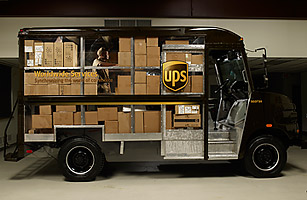
“It looks like this recession is finally over,” declared Scott Davis, CEO of UPS, earlier this month while announcing 2009 earnings that were better than expected for the world’s largest package carrier. Speaking to analysts on Feb. 2, Davis added, “Believe it or not, that makes 21 that UPS has successfully managed through.” No doubt UPS shareholders are relieved after two of the hardest years in the 102-year-old firm’s history. Indeed, only four months ago, the $45 billion company disclosed a 43% drop in third-quarter profit, and 2008 likewise saw staff reductions, shuttered facilities and deep cost controls. Now it appears that UPS’s ability to continually adjust to the economy and its ongoing evolution as a logistics provider has paid off. You may know it as an outfit that delivers the goods, but for UPS it’s becoming less important that the folks in the brown trucks make the final handoff. Delivering a package efficiently is what it gets paid for. And the company is getting paid more often. “It’s very rare to hear such bold statements from UPS management,” says Helane Becker, transportation analyst for Jesup & Lamont Securities. “So we can take this to mean they truly believe the worst is behind us and UPS is ready to move forward.” Good news from UPS may also be good news for Main Street. The Atlanta-based UPS and its main rival, FedEx, are in some ways economic bellwethers. The 15.1 million packages that UPS handles every day translate into about 6% of the U.S.’s gross domestic product and 2% of the world’s. Consider too that the shipping giants may actually be lagging indicators. “In downturns, companies let inventories deplete before they restock,” Becker says. “That means demand–and the economy overall–must go up significantly before UPS’s business improves.” UPS has not escaped this recession unscathed. Revenue last year shrank by about $6 billion from 2008, forcing widespread belt-tightening. Just last month, despite the improved outlook, Davis revealed a major restructuring that included 1,800 management and administrative layoffs. Two weeks later, on Feb. 8, he announced plans to furlough at least 300 of the company’s 2,800 pilots. These cuts come on the heels of a 4% reduction in UPS’s 408,000-strong global workforce in 2009. Yet UPS’s willingness to adapt to changing market conditions has rarely let it down. Founder Jim Casey was 19 at the turn of the 20th century, when he started his private messenger service in Seattle financed by $100 of debt. By 1930, UPS had expanded to the East Coast. Air service was available in every state by 1978 and in 200 countries 15 years later. “As World War II ended, we were still primarily delivering housewives’ packages from the market,” says Greg Niemann, a UPS exec who worked at the company from 1961 to 1995 and is the author of Big Brown. “If we hadn’t looked ahead and moved from retail to wholesale [shipping], we would have been out of business a long time ago.”